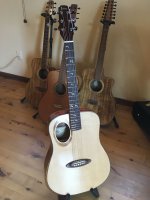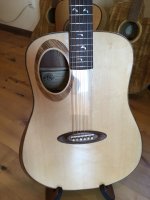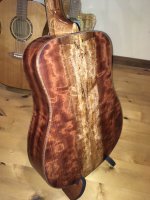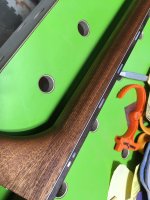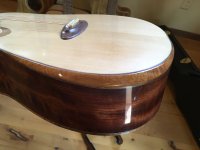Just some pics of the (finally) finished Solariego #13 - "Frankie"
Was a rough winter for building/finishing guitars in an uninsulated/heated barn, even in California!
As usual, this is a charity raffle guitar, boosters covered materials costs, my labor donated, and all proceeds will go to support the band program at our local high school.
A few improvements this year:
1) the articulated neck joint now recesses into a pocket on the guitar body so you don't have to see the ugly gap that sets the neck angle
2) was able to get the CNC to inlay the side markers on the fretboard, not just simple dots anymore!
3) upgraded linear motion components on CNC allowed for "seamless" rosette inlay (no purfling for slop)
4) was able to get the CNC to carve the major X-braces for a perfect parabolic cross section
I now have a youtube channel dedicated to showing how I use the CNC for guitar building:
Was a rough winter for building/finishing guitars in an uninsulated/heated barn, even in California!
As usual, this is a charity raffle guitar, boosters covered materials costs, my labor donated, and all proceeds will go to support the band program at our local high school.
A few improvements this year:
1) the articulated neck joint now recesses into a pocket on the guitar body so you don't have to see the ugly gap that sets the neck angle
2) was able to get the CNC to inlay the side markers on the fretboard, not just simple dots anymore!
3) upgraded linear motion components on CNC allowed for "seamless" rosette inlay (no purfling for slop)
4) was able to get the CNC to carve the major X-braces for a perfect parabolic cross section
I now have a youtube channel dedicated to showing how I use the CNC for guitar building:

